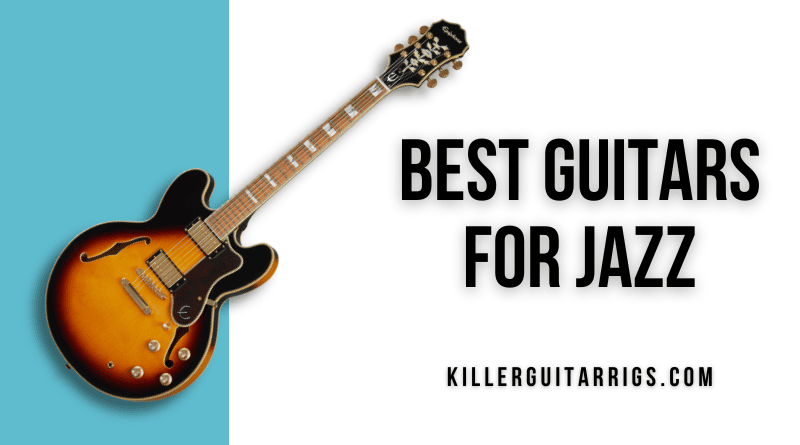As one of the most technically demanding genres of music there is, it makes real sense to invest in one of the best guitars for jazz if you’re going to take your playing seriously, and in our humble opinion, the Epiphone Sheraton-II Pro is the one to go for in the vast majority of cases. This is a semi hollow body electric with some serious luxury appointments, so not only does it sound great, it looks the part, too. Like all the great semi hollows, it has all laminate maple construction, and a thick maple center block for great sustain and feedback prevention. You’ll get fat tone thanks to its Epiphone ProBucker PAF style humbucking pickups, and a versatile range of sounds by way of the coil tapping electronics. It offers superb playability on top of all this, making it one of the best value prospects on the market, and that’s why we named the Epiphone Sheraton-II Pro as our best guitars for jazz Top Pick.
Jazz players looking for something a bit more special should look no further than the legendary Gibson ES-335. Sure, the price tag is high, but this model really is an investment piece. This guitar is hand made in the USA, and built with an all laminate maple body, finished in a nitrocellulose lacquer. The resonance offered by the ES-335 thanks to its maple center block and the ultra breathable nitro finish is simply stunning, and a big part of why this model is held in such high esteem. It’s equipped with the best of the best in terms of electronics, including orange drop capacitors, CTS pots, and calibrated T-Type humbuckers. Besides the tones, one of the many reasons this is such a great choice for jazz is the highly playable neck, and the PLEK’d frets, allowing players to smoothly transition from top to bottom without issue. The Gibson ES-335 is a truly spectacular guitar, and a worthy winner of our best guitars for jazz Editor’s Choice award.
Even if you’re trying to keep costs in check, it’s still possible to get a great jazz guitar, and the Squier Classic Vibe ‘60s Jazzmaster is a prime example. This is an affordable version of the Fender classic, built to extremely similar specs. As evidenced by the model name, this guitar was purpose designed for jazz, and offers one of the most comfortable offset bodies of any guitar and a fantastic slim neck, giving it perfect ergonomics for those complex chord shapes and wild single note runs. This Squier is equipped with Fender designed Alnico single coil pickups that deliver exceptionally smooth tone, and the rhythm and lead circuits, a hallmark of the Jazzmaster, serve up incredible tonal versatility. At this entry level price point, there’s no better guitar for jazz, which is why we named it as our best guitars for jazz Best Budget pick.
Read more about our review process.
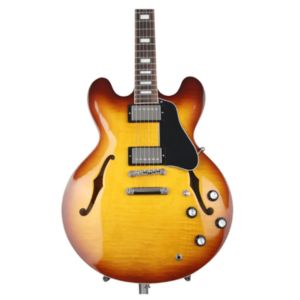
Gibson ES-335
Features: Calibrated T type humbuckers, PLEK'd Frets, AAA Flamed maple top
Benefits: Unmatched tonal versatility, Incredible reliability, Fantastic residual value
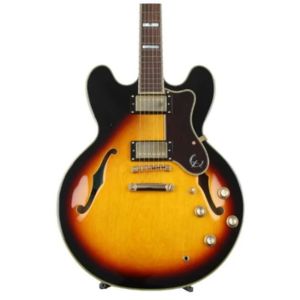
Epiphone Sheraton-II PRO
Features: Grover tuners, Coil tapping pickups, Graphtech nut
Benefits: Incredible sustain, Warm & fat tone, High end fit and finished
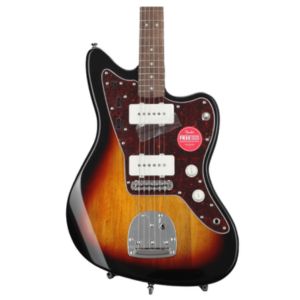
Squier Classic Vibe '60s Jazzmaster
Features: Rhythm & lead tone circuits, Bone nut, Alnico single coil pikcups
Benefits: Extremely versatile, Smooth playing, Comfortable offset design
Contents
Individual Reviews

Epiphone Sheraton-II PRO
Classic semi-hollow sound, feel, and features.
This guitar features a standard semi-hollow body design and construction with a maple body, solid center block for feedback control, and a 5-piece maple/walnut neck for good playability and stability. Add to that great tones with a beautiful shape and body for a fantastic overall playing experience.
The Epiphone Sheraton-II PRO offers players a chance to have authentic semi-hollow body guitar tone, flexibility, and features without having to spend thousands of dollars.
This instrument comes with Epiphone ProBucker pickups, as well as a 4-wire design with coil-tapping that takes after Gibson’s renowned BurstBuckers pickups. The ProBuckers offer you the sound of hand-wound PAF humbuckers, originally designed by pickup mastermind Seth Lover in the late 1950s.
These pickups feature Alnico II magnets, as well as an Elektrisola magnet to match Gibson’s original specifications. In use, we got a huge sound that was quite responsive to our dynamics and attack. This meant we could go from playing gently with extended voicings all the way to aggressive open chords, with great response.
We really liked the neck pickup for playing jazz, bossa nova, and related styles. We got that traditional semi-hollow warm sound with bite. In other words, none of that dullness that some pickups tend to impart in cheaper guitars. The Sheraton II delivered an authentic yet penetrating jazz tone here.
We even liked the neck pickup with a bit of overdrive and the tone knob turned all the way. Here we got a bit of that John Scofield killer tone that works wonders in so many contexts.
With the Sheraton II, you can go beyond traditional Jazz. For fusion and even rock, there is no arguing with the bridge pickup on a good semi-hollow guitar. We dialed in some distortion and got a smooth yet powerful tone, that was punchy on power chords and with great sustain and expression on single lines.
This guitar also feels great when playing. Its playability is mainly due to its SlimTaper neck profile, which was quite comfortable and responsive. In short, a fantastic semi-hollow guitar.
Verdict: The Epiphone Sheraton-II PRO is a great choice for players looking for an authentic semi-hollow body guitar at a fair price. Its tone, playability, flexibility, and overall features make it one of the best choices in the market today.
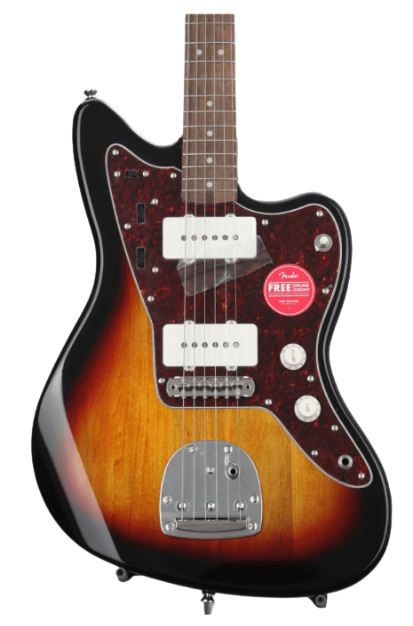
Squier Classic Vibe '60s Jazzmaster
A renowned Fender design, with Squier appointments.
This guitar gives you a vintage jazz tone as well as modern sounds, without breaking the bank. With the classic Jazzmaster design that was quite popular in the 60s and the flexibility to tackle different eras of Jazz, this Jazzmaster is a great choice for beginners who value quality and tradition.
The Squier Classic Vibe ’60s Jazzmaster features a traditional Jazzmaster design with individual lead and rhythm tone circuits. However, it also comes with separate volume controls for each of its two pickups, adding greater tonal range to the instrument.
In our tests, we were happily surprised by this guitar’s playability. With a “C”-shaped bolt-on maple neck, 9.5″ radius, and Indian Laurel fretboard, the Jazzmaster is a joy to play.
Given that Squier is a Fender company, the 25.5″ scale length was to be expected. This is an advantage if you come from playing a Strat or Tele, and will be easier on your hands and overall feel than a full-bodied jazz guitar.
This guitar gave us a nice tone with pep that is sure to cut through any mix. The penetrating jazz tone on this guitar is due to the Fender-designed single-coil pickups, both featuring alnico magnets. In other words, you get a jazzy tone that is very flexible, with that famous snappy Fender tone.
For playing on jazz standards, we preferred the neck pickup with the tone dialed almost all the way down. This gave us a darker tone that was still unmistakably Fender, but much warmer than a Strat or even a Tele.
For fusion tones, we went for the bridge pickup, with the tone still rolled off. Here we got a tone reminiscent of Mike Stern, especially when we added a bit of chorus and overdrive. In short, a nice option for beginners or folks that want to play jazz but remain budget conscious.
Verdict: The Squier Classic Vibe ’60s Jazzmaster features snappy yet jazzy Fender tones, nice playability with a “C”-shaped neck, 9.5″ radius, and is a great option for folks that want an affordable Jazz guitar and like the feel of a Strat or Tele.
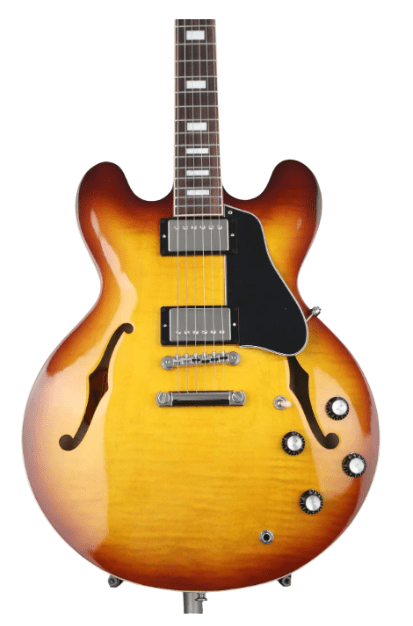
Gibson ES-335
The original and most legendary semi-hollow guitar ever.
This is the instrument that defines what a semi-hollow body guitar is. Simply known as "the 335", this guitar has been one of the most desirable throughout history. It is the instrument of choice of not only many jazz luminaries but also fusion and rock legends.
The Gibson ES-335 is the standard used to measure all other semi-hollow guitars that are measured (which is why there’s such a market for guitars modeled on the ES-335). Featuring premium calibrated T-Type humbucking pickups and its signature center block, the ES-335 sounds and plays superbly, without any feedback issues.
This guitar comes with a quartersawn mahogany neck as well as a Plek’d rosewood fretboard that features rolled binding. The result is a smooth, and very comfortable playing experience for the modern player. The top is AAA-grade maple with a nice Gloss Nitrocellulose Lacquer finish, adding to the 335’s allure.
We were quite excited to try out the real deal. From the beginning, we felt the attention to detail that was put into this instrument. We started with the Calibrated T-Type Rhythm Humbucker neck pickup for a warm and smooth tone that was also very balanced.
Moving on to the bridge pickup, we got a penetrating sound with bite, but the highs were never too much and the frequency response was just right. With overdrive, we got a punchy and beautifully sustained tone, great for fusion, rock, and everything in between.
Naturally, this is a high-quality instrument, and its playability is right on par with its fantastic tone. With a typical 24.75″ Gibson scale length, 12″ radius, and Rounded C Mahogany neck with rosewood fingerboard, the ES-335 feels incredible.
Besides its versatility, great tone, and nice playability, the ES-335 also looks stunning. In short, you get all the great things that a superior instrument has to offer, from the most beloved semi-hollow body guitar model in history.
Verdict: The Gibson ES-335 is the ultimate semi-hollow body guitar, with premium tone, playability, and overall features. Unarguably one of the best choices for jazz, funk, and more, this guitar is for the discerning guitarist who wants the best and is willing to pay for it.
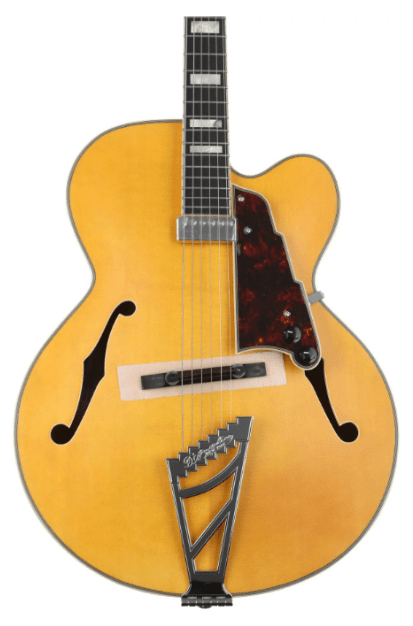
D'Angelico Premier EXL-1
A nice hollow-body guitar for the traditional jazz player.
In the past years, D'Angelico has emerged as one of the best options for guitarists that demand great quality. This guitar is a great example of fine craftsmanship that remains relatively affordable. It is based on D'Angelico's flagship archtop guitar Excel EXL-1, but at a lower cost.
The D’Angelico Premier EXL-1 is a hollow body archtop made from laminated flame maple and spruce. This type of design makes it very resonant and offers a mature voicing even when unplugged.
This guitar is perfect for traditional players in the vein of the great Bucky Pizzarelli. The Premier EXL-1 offers a full jazz guitar experience that is deeply rooted in tradition but with modern appointments for today’s jazz guitarist.
This instrument comes equipped with a Duncan Designed Floating Mini Humbucker on the neck position. This is the only pickup on this guitar, which points it completely towards the traditional jazz guitar tone camp.
In our tests, that is exactly what we got: a warm and round tone, great for playing jazz standards, chord solos, or anything that resembles that great approach of icons of the genre like Wes Montgomery.
Regarding playability, this hollow body felt very comfortable throughout its range. It also felt quite stable and responsive. Its “C”-profile neck is made of 3-piece maple, and features a 14-inch-radius and 22 frets on a 25.5″ scale length. Add to that an Ovangkol fingerboard for a nice feel to match its warm tone.
With its signature D’Angelico headstock, this guitar looks as great as it sounds. Our test model was Honey Blond with a satin finish, to add that final touch of elegance to this instrument.
Verdict: The D’Angelico Premier EXL-1 is a great option for folks looking for a hollow body archtop that delivers a traditional jazz tone and feel.
With fantastic tone and playability, this guitar is for the traditional jazz guitarist. As nice as it is, it may be a bit limiting for those interested in a more modern jazz tone, or in playing any other styles.
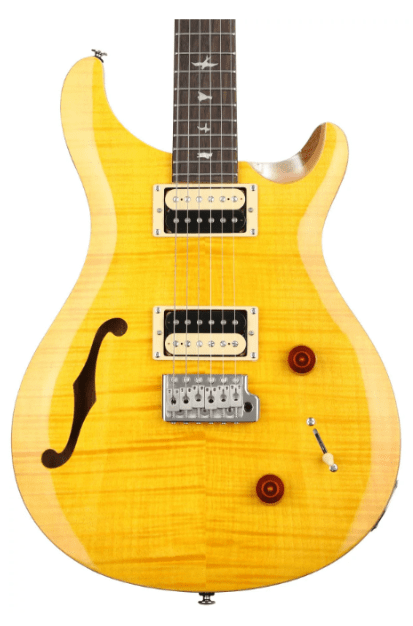
PRS SE Custom 22 Semi-hollow
A modern semi-hollow body guitar for today's player.
This guitar is a thin line semi-hollow with great features for the modern player. It belongs to PRS's renowned SE line, made overseas. This makes the SE line far more affordable than their American-made versions, and quite popular among working guitarists.
PRS SE Custom 22 Semi-hollow features the very popular wood combination of mahogany with maple. A mahogany body is a common choice because it produces natural tonal warmth, which fits nicely with the brighter tone of a maple top. This combination is popular because it produces a balanced sound with a nice amount of body and snap.
This became evident in our tests, as the SE Custom 22 sounded warm enough for jazz, but also able to cut through any mix, especially with the tone knobs turned clockwise.
This guitar is very versatile. We felt comfortable playing not only some jazz heads and solos, but also switching from blues to rock and more. Besides its great wood combination, this SE features the 85/15 “S” pickups. These pickups gave us remarkable clarity as well as an extended tonal range for a variety of styles and situations.
While on the neck pickup, we got everything from beautiful cleans to in-your-face high-gain tones. When it was time to tone it down, we went to the neck pickup for a round yet present jazz tone that responds very well to nuance and dynamics.
The playability of this instrument was also good. We loved its Maple neck with rosewood fingerboard, and our hands felt comfortable around the 10″ radius and 25″ scale length.
Although this is a good guitar, it may not be the first choice for more traditional jazz players, as it is more of a fusion instrument than a bebop one.
Verdict: The PRS SE Custom 22 Semi-hollow is built with the proven wood combination of mahogany with maple for warmth and bite. With a thin line type of construction, this instrument is versatile and good enough for jazz, although more traditional players may feel it’s too modern for them.
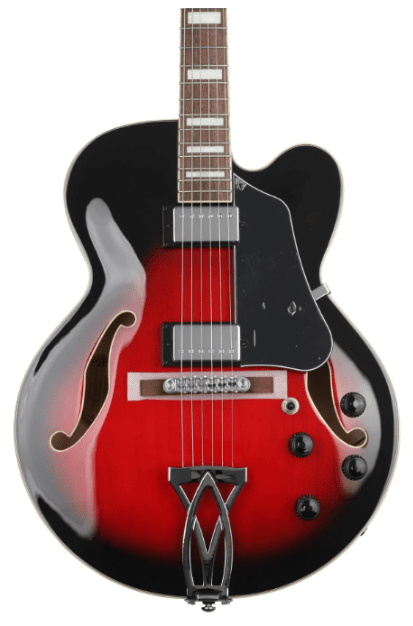
Ibanez Artcore AF75
Affordable quality on a hollow body by a top brand.
Ibanez has been a master at producing good guitars at a fair price and the Artcore AF75 is no exception. With a full body and features that jazz players will appreciate it, this guitar is a good choice, from Bebop to Rockabilly.
The Ibanez Artcore AF75 is a hollow body guitar featuring linden on its top, back, and sides. This wood is a good choice as it provides a nice resonance while keeping costs down.
In our tests, we got a full sound that was warm and projected well. This guitar sounds well unplugged and responded nicely when we tried big band style comping a la Freddie Green. It gave us that percussive touch that still allows enough harmonic information to get through to sound authentic.
With the volume further up, we enjoyed playing through some jazz standards, with an authentic sound and feel. The tone on this Ibanez Artcore is warm and a bit dark, particularly on the neck pickup (classic Elite), where we did most of our jazz playing.
However, this guitar is also capable of expanding beyond jazz thanks to its Classic Elite Humbucker bridge pickup, which gave us a bit of brightness and snap to cut through. Here we played through some chords and lines that may fit quite nicely on a rockabilly or similar style – and it’s that versatility that made it our budget pick in our recent roundup of the best hollow body electric guitars on the market today.
This guitar features a laurel fingerboard, 24.75″ scale length on a 12″ radius, and is relatively good for playability. In short, this is a good instrument for beginners and folks that want a hollow body at an affordable price. It may not be the best choice for players that like modern appointments, particularly regarding its neck and pickup voicings.
Verdict: The Ibanez Artcore AF75 offers you a warm hollow-body tone on a pair of humbuckers that do a good job for the money. This guitar is a good option for players that are looking to get started with jazz. It is also a good choice for those that want a full-bodied electric guitar but are on a budget.
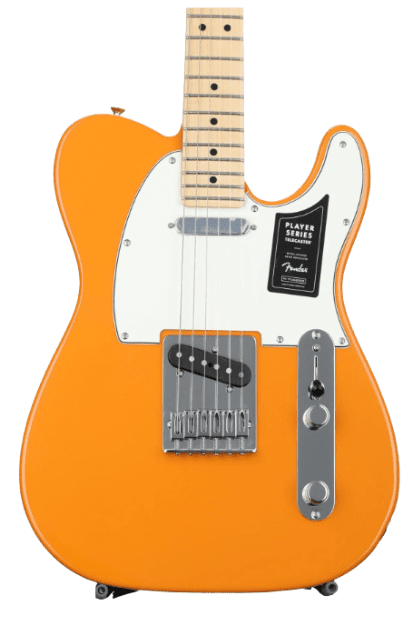
Fender Player Telecaster
Tone and twang in one solid body package.
The Telecaster is one of the unsung heroes of modern jazz. From Mike Stern to Adrian Lage, this type of guitar produces tones that fit perfectly with the bebop vocabulary but with a modern flair. Straight up Tele tone that is fat and punchy, and versatile enough to play jazz and other styles with authority.
The Fender Player Telecaster features an Alder body with the tried and true bolt-on neck design that is beloved all over the world. This guitar is truly versatile and can sound great in many contexts, and jazz is certainly one of them.
In our tests, we loved the response of the single coil Alnico V neck pickup for a modern Jazz sound. The tone here went from warm to punchy with the counterclockwise turn of the tone knob and was a good choice for jazz standards as well as fusion tunes.
For more aggressive styles like rock and country, the neck pickup (also a single coil with Alnico V) gave us that typical Tele bite with ample output. This pickup also proved to be useful for modern jazz when we added a bit of overdrive and rolled the highs back via the tone knob.
This Fender Player Series Tele features a maple neck and a maple fingerboard, for that familiar snappy feel and clear sound. This combination of woods on the neck and fingerboard has been widely used for decades and it’s popular for good reason. The feel and responsiveness are just great.
This Telecaster also includes some modern appointments like a C-shaped neck with a satin urethane finish. Combined with its 9.5″ radius, this guitar felt really good to play and was very responsive as well.
Verdict: The Fender Player Telecaster is ideal for the player that wants a modern guitar that is rooted in tradition. It offers great playability and tone that is versatile and fits many styles, including modern jazz. However, this may not be the best choice for players looking for a more conservative jazz tone and feel.
How to Choose The Right Guitar For You
With so many options available, it can be a bit intimidating to make sense of it all. Here we have given you a basic guide on what to expect from different types of guitars.
Body Type
The body type of any electric guitar has a significant effect on the final tone, and all 3 of the major guitar construction styles are widely used across all the jazz subgenres.
Hollow body
For many, hollow-body guitars are the best choice for playing jazz. Renowned models of these types of guitars tend to be quite pricey, but worth it if you are particularly interested in the warmer and clean tones associated with Jazz and Bebop.
Jazz masters like Charlie Christian, Wes Montgomery, Jim Hall, and Pat Metheny all played hollow-body guitars almost exclusively. Gibson makes several famous hollow bodies, including the ES-175, L-5 and Super 400.
Original models of these guitars can cost thousands of dollars, and although they sound great, they are also fragile. Reissues are not as expensive as the originals, but still unaffordable for most working guitarists.
These guitars are great for traditional jazz, but not a top choice for rock or other styles, as they tend to feedback when distortion is added.
Semi-hollow body
Semi-hollow guitars are also very popular among jazz players. Besides having a smaller acoustic cavity inside them, their design features a center block to eliminate feedback. This is particularly useful for a player that wants to use overdrive, distortion, or fuzz without struggling with unwanted noises.
Master guitarist John Scofield is known for using a semi-hollow with an incredible tone that features distortion. Although he plays funk and other styles, “Sco” is mostly known as a jazz player, and has complete command over the Bebop vocabulary.
Other modern jazz players that use a semi-hollow include Kurt Rosenwinkel and Adam Rogers.
Popular semi-hollow guitar models include the Gibson ES-335, Epiphone Casino and Collings Soco Deluxe.
Solid-body
Solid-body guitars are the most present and dominant type of electric guitars. This is because they offer great versatility, can take numerous types of effects pedals well, and generally lack the issues associated with other types of guitars, particularly vintage hollow bodies.
These guitars use a solid piece of wood, which increases the mass of the body. The result is that they have a limited ability to receive and transmit vibrations when compared to a hollow-bodied or even semi-hollow guitar. This is one of the main arguments against solid bodies, particularly for jazz players.
However, these guitars are far less prone to feedback and unwanted noises than their hollowed counterparts. They are also much easier to produce and cost a lot less.
The most famous models come from Fender and Gibson. The Stratocaster, Telecaster as well as the Gibson Les Paul have been subject to endless debates on whether which one is better.
Modern jazz players tend to gravitate toward solid bodies. Good examples of this are Wayne Krantz (Stratocaster), Julian Lage (Telecaster), Al Di Meola (Les Paul and PRS), and Bill Frisell (Telecaster).
Final Thoughts
The best jazz guitars come in several shapes and with varying features. Tone, just like taste, can be very subjective, and the same can be said about feel and approach. Manufacturers know this, and do their best to please most guitarists and their preferences.
To recap our favorite, the Epiphone Sheraton-II PRO is Our Pick for this list, a great semi-hollow with a nice jazz tone and playability. The Squier Classic Vibe ’60s Jazzmaster is our Best Budget option. And the Gibson ES-335 is our Editor’s Choice with superb sound and feels.

